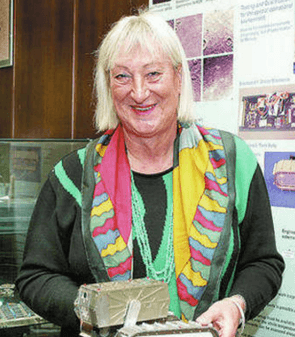Hanna von Hoerner facts for kids
Quick facts for kids
Hanna von Hoerner
|
|
|---|---|
 |
|
| Born | 14 November 1942 |
| Died | 4 July 2014 (aged 71) |
| Education | PhD |
| Alma mater | University Heidelberg University |
| Awards | 2013 Order of Merit of the Federal Republic of Germany 2009 Order of Merit of Baden-Württemberg |
Hanna von Hoerner (born November 14, 1942 – died July 4, 2014) was a German scientist who studied space, called an astrophysicist. She started her own company, von Hoerner & Sulger. This company makes special tools for science, especially for space missions. They are famous for making 'cosmic dust analyzers' used by space agencies like the ESA and NASA.
Contents
Early Life and Discoveries
Hanna von Hoerner was born in Görlitz, Germany, in 1942. Her father, Sebastian von Hoerner, was also an astrophysicist. He encouraged her love for science. When she was only six years old, she was already repairing radios! By the age of fourteen, she built an oscilloscope, which is a tool used to see electrical signals.
In the early 1960s, after finishing high school (called Abitur in Germany), her father moved to the National Radio Astronomy Observatory (NRAO) in the United States. Hanna went with him. There, she completed her electronics training. She also worked as a research assistant at the NRAO, helping with scientific studies.
Education and Return to Germany
In 1965, Hanna von Hoerner returned to Germany. She went to Heidelberg University to study experimental physics. This field focuses on doing experiments to understand how the world works. She earned her first university degree in 1971. Then, in 1974, she completed her PhD, also at Heidelberg University.
Career in Space Science
Even while she was still working on her PhD in 1973, Hanna von Hoerner started her own company, von Hoerner & Sulger. The company is located in Schwetzingen, Germany. It creates special scientific instruments for use in space and even in medicine.
In 1980, her company developed the first mass spectrometer that could work in space. A mass spectrometer is a device that helps scientists figure out what tiny particles are made of.
Designing Dust Analyzers
In 1979, the Max Planck Institute for Solar System Research asked von Hoerner's company to design a special detector. This detector was meant to find cosmic dust for the Vega program missions. These missions were going to Venus.
Later, in 1999, von Hoerner & Sulger designed CIDA. CIDA stands for Cometary and Interstellar Dust Analyzer. This amazing tool was put on board the NASA spacecraft Stardust, which launched in 1999. The Stardust mission collected samples of dust from a comet and brought them back to Earth!
The company is also very well known for designing COSIMA. COSIMA means Cometary Secondary Ion Mass Analyser. This instrument was on board the Rosetta spacecraft. The Rosetta mission studied Comet 67P/C-G. COSIMA helped scientists analyze the tiny dust particles from the comet. It used a method called secondary ion mass spectrometry to find out what the dust was made of. Early information from COSIMA included pictures of dust particles and details about their chemical makeup.
Awards and Recognition
Hanna von Hoerner received several important awards for her work:
- In 2009, she was given the Order of Merit of Baden-Württemberg. This is a high honor from the German state of Baden-Württemberg.
- In 2013, she received the Order of Merit of the Federal Republic of Germany First Class. This award recognized her important contributions to space science in Germany.
- In 2016, a comet was named after her to honor her achievements.
She was also a member of important groups, including:
- The Space Forum in the BDLI (German Aerospace Industries Association).
- The Board of Trustees of the Max Planck Institute for Solar System Research.
- The DLR Space Program Committee.
See also
 In Spanish: Hanna von Hoerner para niños
In Spanish: Hanna von Hoerner para niños


